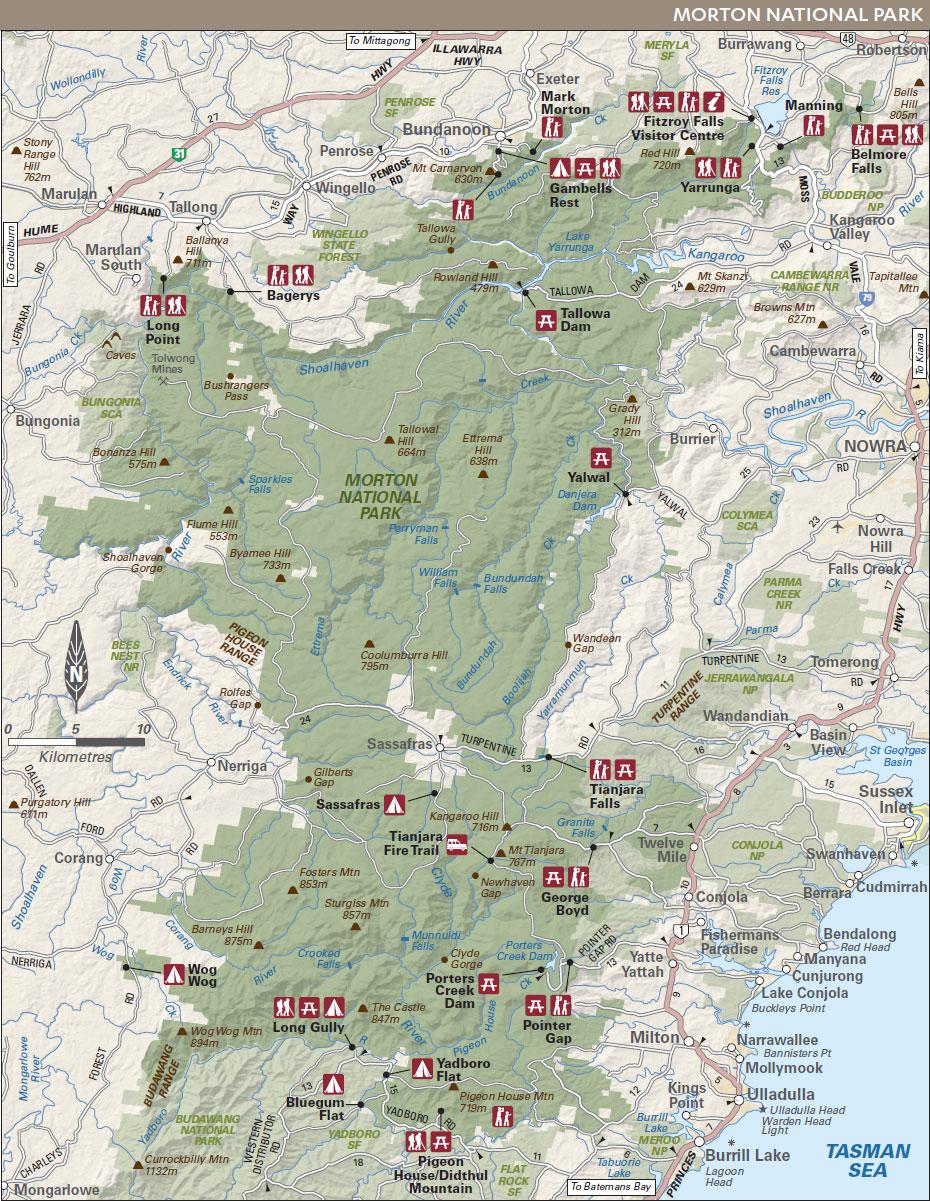

The rugged Budawang Ranges, with their unusual formations, tower above the landscape
PARK INFORMATION
NSWNPWS 1300 361 967 | Fitzroy Falls Visitor Centre (02) 4887 7270 | NPWS Ulladulla (02) 4454 9500
SIZE
192 352 ha
LOCATION
115 km south of Sydney; 18 km south of Moss Vale; 2 km south of Bundanoon; 24 km west of Nowra
ACCESS
From Wollongong via Illawarra Hwy to Belmore Falls and Fitzroy Falls; from Ulladulla and Milton in the east and Goulburn and Marulan in the west (southern section); from Princes Hwy between Ulladulla and Nowra, and from Nowra–Moss Vale Rd (route 79)
PERMITS
Written permission required in advance for rock-climbing and canyoning; permit required from NPWS Ulladulla to drive the Tianjara Fire Trail
BEST SEASON
All year
VISITOR INFORMATION
Bundanoon/Moss Vale 1300 657 559 | Nowra 1300 662 808 | www.shoalhaven.nsw.gov.au
MUST SEE, MUST DO
CALL in at the Fitzroy Falls Visitor Centre for an overview of attractions
CLIMB to the top of Pigeon House Mountain
SEE Fitzroy Falls plummeting over the escarpment
HIRE a mountain bike and explore the Bundanoon area
Morton National Park is a world of dense bush, an expanse of spectacular sandstone country on the eastern escarpment of the Southern Tablelands, its plateau rent by deep gullies and thundering waterfalls, and in the south, mountainous terrain and tracts of wilderness including the rugged Budawang Ranges.
This national park has been a retreat for visitors for more than a century and well-developed visitor sites are a feature in the northern section. In the south, experienced walkers can savour the wilderness.
Aboriginal culture
The area is rich in Aboriginal cultural sites and many of the valleys and ridge lines were traditionally part of a route from the hinterland to the coast.
A look at the past
One of the park’s most arresting landmarks is Pigeon House Mountain, named by Captain Cook in 1770 as he tacked up the eastern coast of the continent. Early European exploration of the region focused on finding a route from the coast to the inland regions, but soon settlers arrived to mine, log and farm the country and scattered remnants of settlement from those days remain. Morton National Park was established in 1938.
Natural features and native plants
The powerful Shoalhaven River flows through the park, as does a web of smaller rivers and creeks. Vegetation is a patchwork of tall eucalypt forest, mallee woodlands and heathland, with cool temperate rainforest thriving in sheltered aspects and in the moist fertile soil along creeks. Extensive tracts are officially declared wilderness areas.
Wildlife
In open forest and woodland eastern grey kangaroos, wallaroos, the common wombat, possums and gliders make up most of the animal population. Powerful raptors such as the wedge-tailed eagle and peregrine falcon patrol the escarpment in search of prey. The heathland is home to two endangered species, the ground parrot and eastern bristlebird, and eastern spinebills and numerous species of honeyeaters dart among the nectar-rich heath and flowering plants. Watch for eastern snake-necked turtles in and near the waterways and do not miss the glow-worms at night.
Camping and accommodation
There is just one camping area in the north of the park (hot showers, bookings essential) and a couple in the park’s south. Bush camping is permitted in many areas but not in parts of the Budawang wilderness (check first for details). Campfires are generally not permitted in Morton National Park so campers must be totally self-sufficient and carry a liquid-fuel stove.
Things to do
Call in to the Fitzroy Falls Visitor Centre for helpful information on the attractions of this park. A wheelchair-friendly boardwalk leads to the falls and excellent views. The centre also has a cafe.
BUSHWALKING Ask at the visitor centre for a list of walking tracks – they are numerous. In the northern section of the park, there is East Rim Wildflower Walk (5 km return, 4 hours, easy). Follow the well-marked trail with its interpretive signs and enjoy wildflowers in spring, sheer chasms and panoramic views. Belmore Falls Walk (1.5 km return, 45 minutes, easy) from Hindmarsh Lookout carpark, rewards with views across Kangaroo Valley, and past banksia and wattle to the impressive falls. Other walks include those to the Erith Coal Mine, Fern Tree Gully, Glow Worm Glen, Granite Falls Lookout and Long Point Lookout.
In the southern part of the park, Pigeon House Mountain Didthul Walk (2.5 km, 4 hours, hard) is steep in parts (the final ascent is by ladders in the rock face) but a rewarding climb to reach the mountain’s stony peak. Large lace monitors sometimes cross the track. All walkers should be well equipped, and carry a compass, topographic maps and drinking water.
CYCLING A number of trails are suitable for mountain-bike riders. Fire trails around Bundanoon – popular with families – lead to lookouts over Bundanoon Gullies. The ride from Fitzroy Falls to Kangaroo Valley (30 km, leaves from the visitor centre) is a little more challenging, as it includes some steep sections. Register with the visitor centre before departure.
OTHER ACTIVITIES Breathtaking views from many vantage points are an outstanding feature of the park: Long Point Lookout (for a wonderful view of the Shoalhaven River), Bagerys Lookout, Gambells Rest, Fitzroy Falls, Belmore Lookout, Tianjara Falls and George Boyd Lookout are just a few. There are opportunities for canyoning and rock-climbing but written permission from the NPWS is required in advance. Four-wheel drive touring is limited; to undertake the 17-kilometre Tianjara Fire Trail route you will need permission from the NPWS Ulladulla office.
